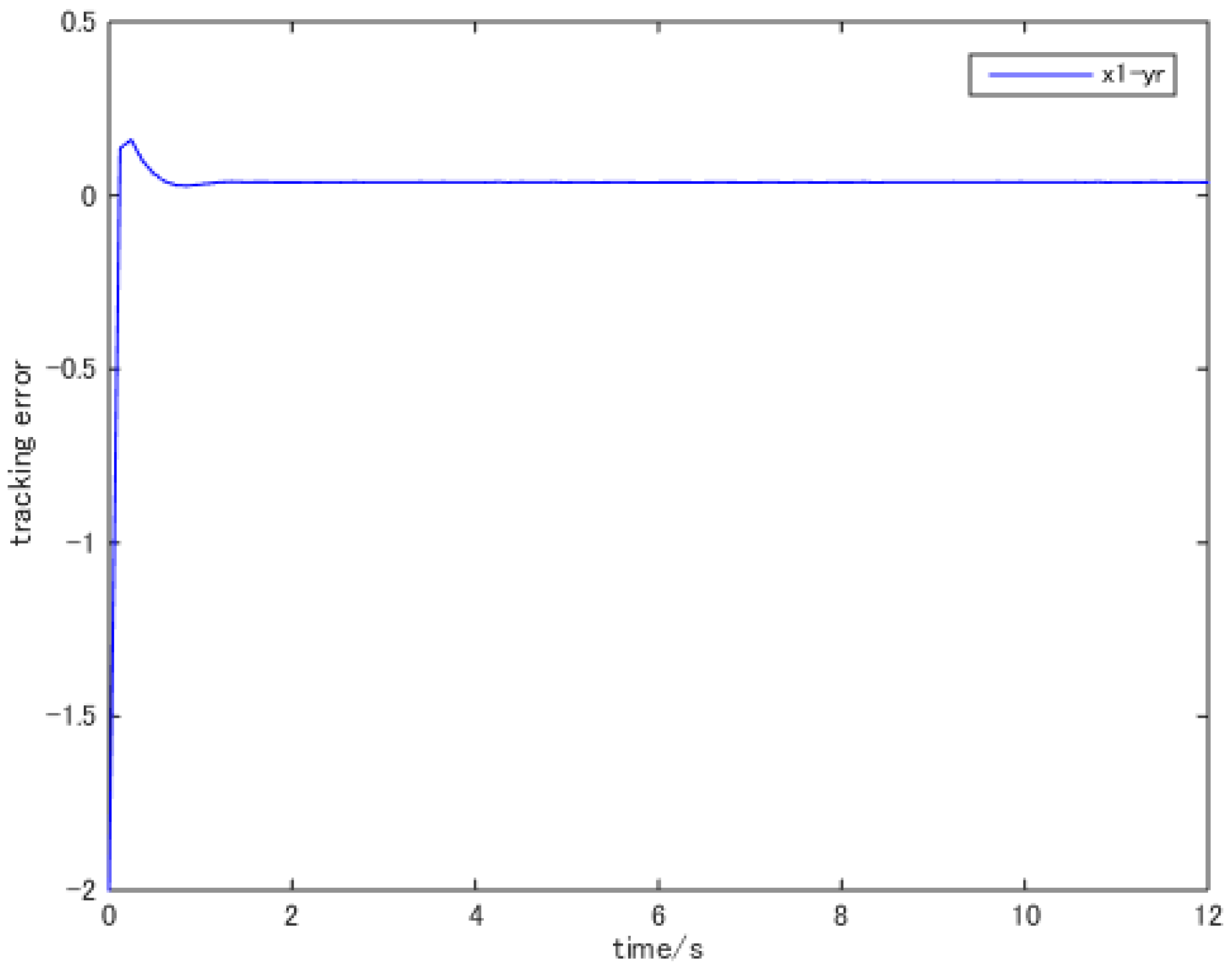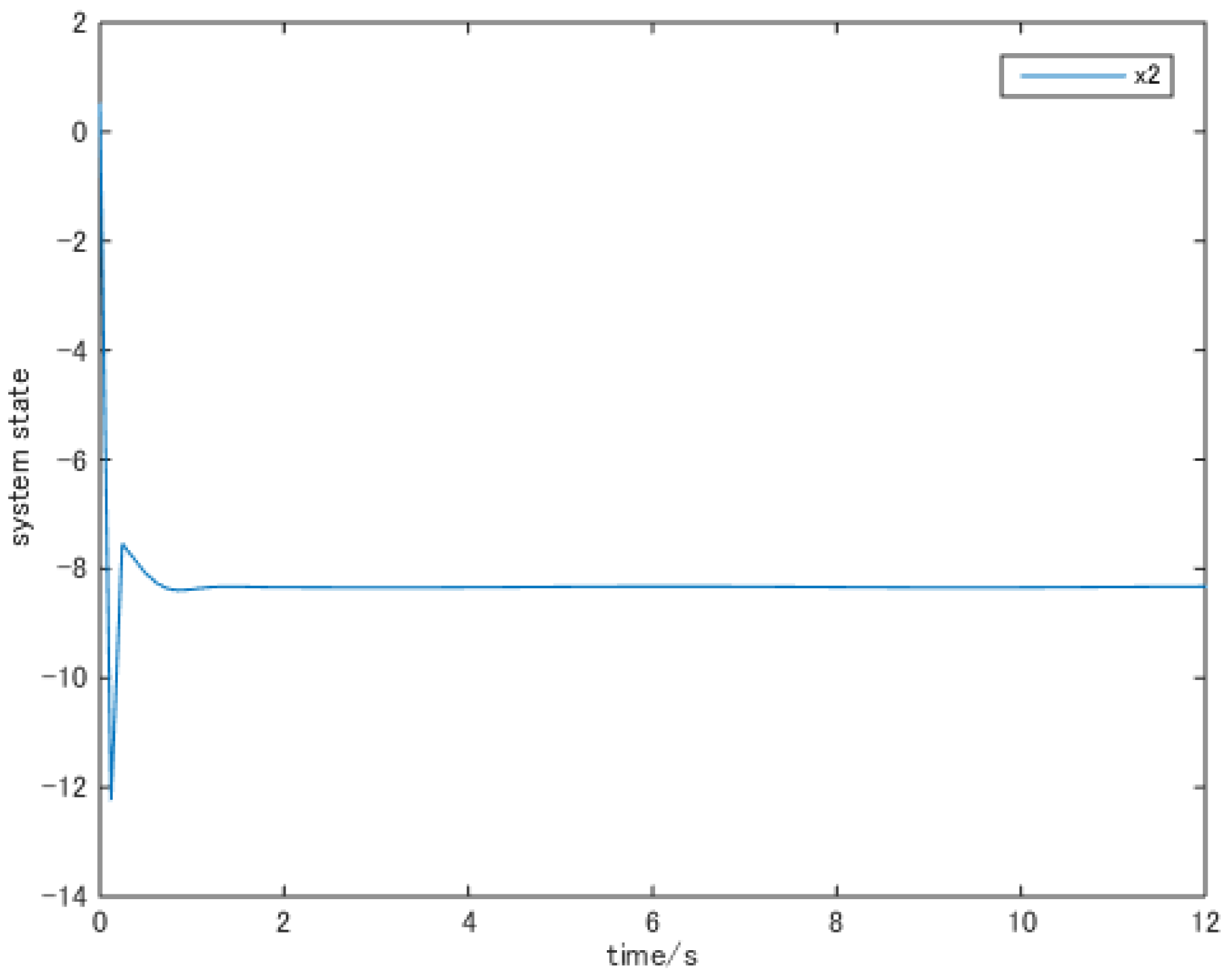Output Tracking Control for High-Order Nonlinear Systems with Time Delay via Output Feedback Design
Abstract
:1. Introduction
2. Mathematical Preliminaries
- (i)
- The dilation is defined by , with being called as the weights of the coordinate. For simplicity, we define dilation weight.
- (ii)
- A function is said to be homogeneous of degree m () if
- (iii)
- A vector field is said to be homogeneous of degree k if the component is homogeneous of degree for each i, that is, , .
- (iv)
- denote a homogeneous -norm. For simplicity, write for .
- (i)
- is homogeneous of degreewithbeing the homogeneous weight of.
- (ii)
- There is a constantsuch that. Moreover, ifis positive definite, there is a constantsuch that.
3. Problem Formulation and Key Assumptions
4. Output Tracking Control via Output Feedback Design
5. Example and Simulation
6. Conclusions
Author Contributions
Funding
Institutional Review Board Statement
Informed Consent Statement
Data Availability Statement
Acknowledgments
Conflicts of Interest
References
- Čelikovský, S.; Huang, J. Continuous feedback practical output regulation for a class of non-linear systems having non-stabilizable linearization. In Proceedings of the 38th IEEE Conference on Decision and Control, Phoenix, AZ, USA, 7–10 December 1999; pp. 4796–4801. [Google Scholar]
- Qian, C.; Lin, W. Practical output tracking of nonlinear systems with uncontrollable unstable linearization. IEEE Trans. Autom. Control. 2002, 47, 21–36. [Google Scholar] [CrossRef]
- Lin, W.; Pongvuthithum, R. Adaptive output tracking of inherently nonlinear systems with nonlinear parameterization. IEEE Trans. Autom. Control. 2003, 48, 1737–1749. [Google Scholar] [CrossRef]
- Gong, Q.; Qian, C. Global Practical Output Regulation of a Class of Nonlinear Systems by Output Feedback. Automatica 2007, 43, 184–189. [Google Scholar] [CrossRef] [Green Version]
- Sun, Z.-Y.; Liu, Y.-G. Adaptive Practical Output Tracking Control for High-order Nonlinear Uncertain Systems. Acta Autom. Sin. 2008, 34, 984–989. [Google Scholar] [CrossRef]
- Alimhan, K.; Inaba, H. Practical output tracking by smooth output compensator for uncertain nonlinear systems with unstabilisable and undetectable linearization. Int. J. Model. Identif. Control 2008, 5, 1–13. [Google Scholar] [CrossRef]
- Alimhan, K.; Inaba, H. Robust practical output tracking by output compensator for a class of uncertain inherently non-linear systems. Int. J. Model. Identif. Control. 2008, 4, 304. [Google Scholar] [CrossRef]
- Bi, W.P.; Zhang, J.F. Global practical tracking control for high-order nonlinear uncertain systems. In Proceedings of the Chinese Control and Decision Conference, Xuzhou, China, 26–28 May 2010; pp. 1619–1622. [Google Scholar]
- Yan, X.; Liu, Y. Global Practical Tracking for High-Order Uncertain Nonlinear Systems with Unknown Control Directions. SIAM J. Control. Optim. 2010, 48, 4453–4473. [Google Scholar] [CrossRef]
- Yan, X.; Liu, Y. Global practical tracking by output-feedback for nonlinear systems with unknown growth rate. Sci. China Inf. Sci. 2011, 54, 2079–2090. [Google Scholar] [CrossRef]
- Zhai, J.; Fei, S. Global practical tracking control for a class of uncertain non-linear systems. IET Control. Theory Appl. 2011, 5, 1343–1351. [Google Scholar] [CrossRef]
- Alimhan, K.; Otsuka, N. A Note on Practically Output Tracking Control of Nonlinear Systems That May not Be Linearizable at the Origin. Communications in Computer and Information Science; Springer: Berlin/Heidelberg, Germany, 2011; Volume 256 CCIS, pp. 17–25. [Google Scholar]
- Yan, X.; Liu, Y. The further result on global practical tracking for high-order uncertain nonlinear systems. J. Syst. Sci. Complex. 2012, 25, 227–237. [Google Scholar] [CrossRef]
- Alimhan, K.; Otsuka, N.; Adamov, A.A.; Kalimoldayev, M.N. Global practical output tracking of inherently non-linear systems using continuously differentiable controllers. Math. Probl. Eng. 2015, 2015, 932097. [Google Scholar] [CrossRef]
- Alimhan, K.; Otsuka, N.; Kalimoldayev, M.N.; Adamov, A.A. Output Tracking Problem of Uncertain Nonlinear Systems with High-Order Nonlinearities. In Proceedings of the 2015 8th International Conference on Control and Automation, Jeju, Korea, 25–28 November 2015; pp. 1–4. [Google Scholar]
- Guo, L.-C. Practical tracking control for stochastic nonlinear systems with polynomial function growth conditions. Automatika 2019, 60, 443–450. [Google Scholar] [CrossRef] [Green Version]
- Alimhan, K.; Otsuka, N.; Kalimoldayev, M.N.; Tasbolatuly, N. Output Tracking by State Feedback for High-Order Nonlinear Systems with Time-Delay. J. Theor. Appl. Inf. Technol. 2019, 97, 942–956. [Google Scholar]
- Alimhan, K.; Mamyrbayev, O.; Erdenova, A.; Akmetkalyeva, A. Global output tracking by state feedback for high-order nonlinear systems with time-varying delays. Cogent Eng. 2020, 7, 1711676. [Google Scholar] [CrossRef]
- Sun, Z.; Liu, Y.; Xie, X. Global stabilization for a class of high-order time-delay nonlinear systems. Int. J. Innov. Comput. Inf. Control 2011, 7, 7119–7130. [Google Scholar]
- Sun, Z.; Xie, X.; Liu, Z. Global stabilization of high-order nonlinear systems with multiple time delays. Int. J. Control 2013, 86, 768–778. [Google Scholar] [CrossRef]
- Sun, Z.; Zhang, X.; Xie, X. Continuous global stabilization of high-order time-delay nonlinear systems. Int. J. Control 2013, 86, 994–1007. [Google Scholar] [CrossRef]
- Chai, L. Global Output Control for a Class of Inherently Higher-Order Nonlinear Time-Delay Systems Based on Homogeneous Domination Approach. Discret. Dyn. Nat. Soc. 2013, 2013, 1–6. [Google Scholar] [CrossRef]
- Zhang, N.; Zhang, E.; Gao, F. Global Stabilization of High-Order Time-Delay Nonlinear Systems under a Weaker Condition. Abstr. Appl. Anal. 2014, 2014, 1–8. [Google Scholar] [CrossRef]
- Gao, F.; Wu, Y. Further results on global state feedback stabilization of high-order nonlinear systems with time-varying delays. ISA Trans. 2015, 55, 41–48. [Google Scholar] [CrossRef] [PubMed]
- Gao, F.; Wu, Y. Global stabilisation for a class of more general high-order time-delay nonlinear systems by output feedback. Int. J. Control. 2015, 88, 1–14. [Google Scholar] [CrossRef]
- Zhang, X.; Lin, W.; Lin, Y. Nonsmooth Feedback Control of Time-Delay Nonlinear Systems: A Dynamic Gain Based Approach. IEEE Trans. Autom. Control. 2016, 62, 438–444. [Google Scholar] [CrossRef]
- Yan, X.; Song, X. Global Practical Tracking by Output Feedback for Nonlinear Systems with Unknown Growth Rate and Time Delay. Sci. World J. 2014, 2014, 1–7. [Google Scholar] [CrossRef] [PubMed] [Green Version]
- Jia, X.; Xu, S.; Chen, J.; Li, Z.; Zou, Y. Global output feedback practical tracking for time-delay systems with uncertain polynomial growth rate. J. Frankl. Inst. 2015, 352, 5551–5568. [Google Scholar] [CrossRef]
- Jia, X.; Xu, S. Global practical tracking by output feedback for nonlinear time-delay systems with uncertain polynomial growth rate. In Proceedings of the 2015 34th Chinese Control Conference (CCC), Hangzhou, China, 28–30 July 2015; pp. 607–611. [Google Scholar]
- Jia, X.; Xu, S.; Ma, Q.; Qi, Z.; Zou, Y. Global practical tracking by output feedback for a class of non-linear time-delay systems. IMA J. Math. Control. Inf. 2016, 33, 1067–1080. [Google Scholar] [CrossRef]
- Rosier, L. Homogeneous Lyapunov function for homogeneous continuous vector field. Syst. Control. Lett. 1992, 19, 467–473. [Google Scholar] [CrossRef]
- Polendo, J.; Qian, C. A generalized homogeneous domination approach for global stabilization of inherently nonlinear systems via output feedback. Int. J. Robust Nonlinear Control. 2007, 17, 605–629. [Google Scholar] [CrossRef]
- Polendo, J.; Qian, C. A universal method for robust stabilization of nonlinear systems: Unification and extension of smooth and non-smooth approaches. In Proceedings of the 2006 American Control Conference, Minneapolis, MN, USA, 14–16 June 2006. [Google Scholar]
- Zhai, J.-Y. Finite-Time Output Feedback Stabilization for Stochastic High-Order Nonlinear Systems. Circuits Syst. Signal Process. 2014, 33, 3809–3837. [Google Scholar] [CrossRef]
- Zhai, J.-Y.; Du, H.-B. Global output feedback stabilisation for a class of upper triangular stochastic nonlinear systems. Int. J. Control. 2014, 87, 1–12. [Google Scholar] [CrossRef]
- Zhai, J.-Y.; Song, Z.; Karimi, H.R. Global finite-time control for a class of switched nonlinear systems with different powers via output feedback. Int. J. Syst. Sci. 2018, 49, 2776–2783. [Google Scholar] [CrossRef]




Publisher’s Note: MDPI stays neutral with regard to jurisdictional claims in published maps and institutional affiliations. |
© 2021 by the authors. Licensee MDPI, Basel, Switzerland. This article is an open access article distributed under the terms and conditions of the Creative Commons Attribution (CC BY) license (https://creativecommons.org/licenses/by/4.0/).
Share and Cite
Alimhan, K.; Mamyrbayev, O.J.; Abdenova, G.A.; Akmetkalyeva, A. Output Tracking Control for High-Order Nonlinear Systems with Time Delay via Output Feedback Design. Symmetry 2021, 13, 675. https://doi.org/10.3390/sym13040675
Alimhan K, Mamyrbayev OJ, Abdenova GA, Akmetkalyeva A. Output Tracking Control for High-Order Nonlinear Systems with Time Delay via Output Feedback Design. Symmetry. 2021; 13(4):675. https://doi.org/10.3390/sym13040675
Chicago/Turabian StyleAlimhan, Keylan, Orken J. Mamyrbayev, Gaukhar A. Abdenova, and Almira Akmetkalyeva. 2021. "Output Tracking Control for High-Order Nonlinear Systems with Time Delay via Output Feedback Design" Symmetry 13, no. 4: 675. https://doi.org/10.3390/sym13040675







